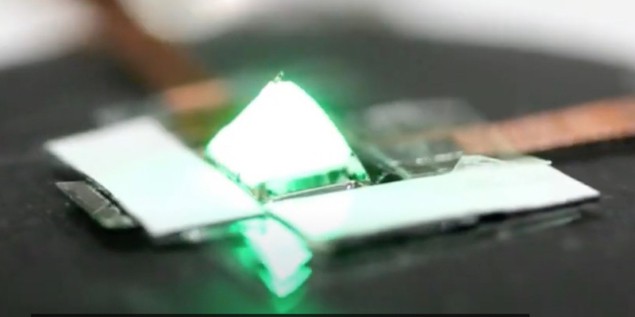Quantum dot LEDs bend and fold like origami paper
10 Nov 2021 Isabelle Dumé
A new ultrathin quantum dot light-emitting diode (QLED) that bends and creases like a piece of origami paper could be ideal for next-generation displays and foldable mobile phones. The device was made using laser etching, and researchers at the Institute of Basic Sciences in Korea say that the same technique could also be used to create QLED structures with complex 3D shapes that stand up to repeated folding.
Flexible light-emitting devices based on quantum dots and organic luminophores are at the heart of modern display technologies. Some devices made from these electroluminescent materials are now so thin – QLEDs, in particular, can be thinner than 5 microns – that they continue to operate despite being bent, folded or even rolled up. Researchers are now looking to go beyond these technologies and develop displays that can transform from 2D to 3D or vice versa. Such displays could be used in next-generation large-scale screens or miniaturized for use in mobile phones.
Origami technique cuts and folds
Origami is a simple and reliable way to convert 2D materials into 3D structures, and it has recently been applied in electronics to make a 3D photodetector array out of molybdenum diselenide. In that case, researchers converted an ultrathin 2D photodetector into a dome-shaped 3D pop-up structure.
In the latest work, which is described in Nature Electronics, a team led by Dae-Hyeong Kim and Taeghwan Hyeon of the Center for Nanoparticle Research at the IBS used a new type of laser patterning technique to form folding and cutting lines in conventional planar QLEDS. In the team’s fabrication process, the light-emitting layers of the material are protected from over-etching by a silver-based “etch-stop” layer deposited on the QLED surface. A pulsed, power-controlled carbon dioxide laser enables researchers to precisely control the depth of etching. Since the laser-etched part of the device is thinner than the surrounding area, the device folds easily along these etched lines.
Protected from external strain
Kim, Hyeon and colleagues succeeded in creating QLED architectures with bending radii of just 0.047 mm. Accordingly, the fold lines on the devices resemble sharp edges with no visible curves, allowing the devices to be folded into 3D structures in which the fold lines take on most of the applied deformation. The finished devices are thus protected from external strain and continue to emit light even after they are repeatedly folded 500 times.READ MORE

The researchers used their foldable QLEDs to build a star-shaped passive matrix array displaying letters and numbers, as well as other 3D structures shaped like a pyramid, a cube, an aeroplane and even a butterfly. Kim notes that while the IBS team fabricated QLED arrays composed of 64 individual pixels, the same technique could be used to make more complex displays in the future.
The researchers now plan to develop deformable QLEDs that can take on various form factors for next-generation displays. In the longer term, Hyeon suggests that the new technique could be used to create electronic paper that folds as easily as the traditional kind. “Who knows when the day will come when electronic paper with a display unit can replace real paper?” he says.
from physicsworld.com 11/11/2021

Δεν υπάρχουν σχόλια:
Δημοσίευση σχολίου